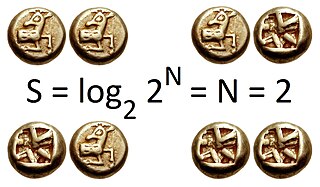
In algorithmic information theory, the Kolmogorov complexity of an object, such as a piece of text, is the length of a shortest computer program that produces the object as output. It is a measure of the computational resources needed to specify the object, and is also known as algorithmic complexity, Solomonoff–Kolmogorov–Chaitin complexity, program-size complexity, descriptive complexity, or algorithmic entropy. It is named after Andrey Kolmogorov, who first published on the subject in 1963.

In information theory, the entropy of a random variable is the average level of "information", "surprise", or "uncertainty" inherent to the variable's possible outcomes. Given a discrete random variable , with possible outcomes , which occur with probability the entropy of is formally defined as:
In mathematics, an ultrametric space is a metric space in which the triangle inequality is strengthened to . Sometimes the associated metric is also called a non-Archimedean metric or super-metric. Although some of the theorems for ultrametric spaces may seem strange at a first glance, they appear naturally in many applications.
In algorithmic information theory, algorithmic probability, also known as Solomonoff probability, is a mathematical method of assigning a prior probability to a given observation. It was invented by Ray Solomonoff in the 1960s. It is used in inductive inference theory and analyses of algorithms. In his general theory of inductive inference, Solomonoff uses the prior obtained by this formula, in Bayes' rule for prediction.
Solomonoff's theory of inductive inference is a mathematical proof that if a universe is generated by an algorithm, then observations of that universe, encoded as a dataset, are best predicted by the smallest executable archive of that dataset. This formalization of Occam's razor for induction was introduced by Ray Solomonoff, based on probability theory and theoretical computer science. In essence, Solomonoff's induction derives the posterior probability of any computable theory, given a sequence of observed data. This posterior probability is derived from Bayes rule and some universal prior, that is, a prior that assigns a positive probability to any computable theory.

In probability theory and information theory, the mutual information (MI) of two random variables is a measure of the mutual dependence between the two variables. More specifically, it quantifies the "amount of information" obtained about one random variable by observing the other random variable. The concept of mutual information is intimately linked to that of entropy of a random variable, a fundamental notion in information theory that quantifies the expected "amount of information" held in a random variable.
Algorithmic information theory (AIT) is a branch of theoretical computer science that concerns itself with the relationship between computation and information of computably generated objects, such as strings or any other data structure. In other words, it is shown within algorithmic information theory that computational incompressibility "mimics" the relations or inequalities found in information theory. According to Gregory Chaitin, it is "the result of putting Shannon's information theory and Turing's computability theory into a cocktail shaker and shaking vigorously."
A height function is a function that quantifies the complexity of mathematical objects. In Diophantine geometry, height functions quantify the size of solutions to Diophantine equations and are typically functions from a set of points on algebraic varieties to the real numbers.
Intuitively, an algorithmically random sequence is a sequence of binary digits that appears random to any algorithm running on a universal Turing machine. The notion can be applied analogously to sequences on any finite alphabet. Random sequences are key objects of study in algorithmic information theory.
The chain rule for Kolmogorov complexity is an analogue of the chain rule for information entropy, which states:
In mathematics, effective dimension is a modification of Hausdorff dimension and other fractal dimensions which places it in a computability theory setting. There are several variations of which the most common is effective Hausdorff dimension. Dimension, in mathematics, is a particular way of describing the size of an object. Hausdorff dimension generalizes the well-known integer dimensions assigned to points, lines, planes, etc. by allowing one to distinguish between objects of intermediate size between these integer-dimensional objects. For example, fractal subsets of the plane may have intermediate dimension between 1 and 2, as they are "larger" than lines or curves, and yet "smaller" than filled circles or rectangles. Effective dimension modifies Hausdorff dimension by requiring that objects with small effective dimension be not only small but also locatable in a computable sense. As such, objects with large Hausdorff dimension also have large effective dimension, and objects with small effective dimension have small Hausdorff dimension, but an object can have small Hausdorff but large effective dimension. An example is an algorithmically random point on a line, which has Hausdorff dimension 0 but effective dimension 1.
The entropic vector or entropic function is a concept arising in information theory. It represents the possible values of Shannon's information entropy that subsets of one set of random variables may take. Understanding which vectors are entropic is a way to represent all possible inequalities between entropies of various subsets. For example, for any two random variables , their joint entropy is at most the sum of the entropies of and of :
In 1973 Kolmogorov proposed a non-probabilistic approach to statistics and model selection. Let each datum be a finite binary string and a model be a finite set of binary strings. Consider model classes consisting of models of given maximal Kolmogorov complexity. The Kolmogorov structure function of an individual data string expresses the relation between the complexity level constraint on a model class and the least log-cardinality of a model in the class containing the data. The structure function determines all stochastic properties of the individual data string: for every constrained model class it determines the individual best-fitting model in the class irrespective of whether the true model is in the model class considered or not. In the classical case we talk about a set of data with a probability distribution, and the properties are those of the expectations. In contrast, here we deal with individual data strings and the properties of the individual string focused on. In this setting, a property holds with certainty rather than with high probability as in the classical case. The Kolmogorov structure function precisely quantifies the goodness-of-fit of an individual model with respect to individual data.

Paul Michael Béla Vitányi is a Dutch computer scientist, Professor of Computer Science at the University of Amsterdam and researcher at the Dutch Centrum Wiskunde & Informatica.
The Normalized Google Distance (NGD) is a semantic similarity measure derived from the number of hits returned by the Google search engine for a given set of keywords. Keywords with the same or similar meanings in a natural language sense tend to be "close" in units of Normalized Google Distance, while words with dissimilar meanings tend to be farther apart.
A zone diagram is a certain geometric object which a variation on the notion of Voronoi diagram. It was introduced by Tetsuo Asano, Jiri Matousek, and Takeshi Tokuyama in 2007.
Normalized compression distance (NCD) is a way of measuring the similarity between two objects, be it two documents, two letters, two emails, two music scores, two languages, two programs, two pictures, two systems, two genomes, to name a few. Such a measurement should not be application dependent or arbitrary. A reasonable definition for the similarity between two objects is how difficult it is to transform them into each other.
In bioinformatics, alignment-free sequence analysis approaches to molecular sequence and structure data provide alternatives over alignment-based approaches.
The distributional learning theory or learning of probability distribution is a framework in computational learning theory. It has been proposed from Michael Kearns, Yishay Mansour, Dana Ron, Ronitt Rubinfeld, Robert Schapire and Linda Sellie in 1994 and it was inspired from the PAC-framework introduced by Leslie Valiant.
In mathematics, the incompressibility method is a proof method like the probabilistic method, the counting method or the pigeonhole principle. To prove that an object in a certain class satisfies a certain property, select an object of that class which is incompressible. If it does not satisfy the property, it can be compressed by computable coding. Since it can be generally proven that almost all objects in a given class are incompressible, the argument demonstrates that almost all objects in the class have the property involved. To select an incompressible object is ineffective, and cannot be done by a computer program. However, a simple counting argument usually shows that almost all objects of a given class can be compressed by only a few bits.





























